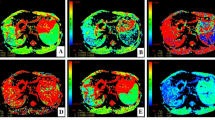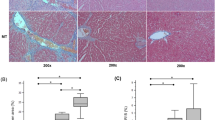Abstract
Objectives
To develop a non-invasive MRI method for evaluation of liver fibrosis, with histological analysis as the reference standard.
Methods
The study protocol was approved by the Institutional Review Board for Human Studies of our hospital, and written informed consent was obtained from all subjects. Seventy-nine subjects who received dynamic contrast-enhanced MRI (DCE-MRI) with Gd-EOB-DTPA were divided into three subgroups according to Metavir score: no fibrosis (n = 30), mild fibrosis (n = 34), and advanced fibrosis (n = 15). The DCE-MRI parameters were measured using two models: (1) dual-input single-compartment model for arterial blood flow (F a), portal venous blood flow, total liver blood flow, arterial fraction (ART), distribution volume, and mean transit time; and (2) curve analysis model for Peak, Slope, and AUC. Statistical analysis was performed with Student’s t-test and the nonparametric Kruskal-Wallis test.
Results
Slope and AUC were two best perfusion parameters to predict the severity of liver fibrosis (>F2 vs. ≦F2). Four significantly different variables were found between non-fibrotic versus mild-fibrotic subgroups: F a, ART, Slope, and AUC; the best predictor for mild fibrosis was F a (AUROC:0.701).
Conclusions
DCE-MRI with Gd-EOB-DTPA is a noninvasive imaging, by which multiple perfusion parameters can be measured to evaluate the severity of liver fibrosis.
Key Points
• Dynamic Gd-EOB-DTPA contrast-enhanced-MRI can help evaluate the severity of liver fibrosis.
• Slope and AUC were two best perfusion parameters to predict severity.
• Absolute arterial blood flow was the best predictor for mild fibrosis.




Similar content being viewed by others
References
Afdhal NH, Nunes D (2004) Evaluation of liver fibrosis: a concise review. Am J Gastroenterol 99:1160–1174
Atzori L, Poli G, Perra A (2009) Hepatic stellate cell: a star cell in the liver. Int J Biochem Cell Biol 41:1639–1642
Pandharipande PV, Krinsky GA, Rusinek H, Lee VS (2005) Perfusion imaging of the liver: current challenges and future goals. Radiology 234:661–673
West J, Card TR (2010) Reduced mortality rates following elective percutaneous liver biopsies. Gastroenterology 139:1230–1237
Seeff LB, Everson GT, Morgan TR, Curto TM, Lee WM, Ghany MG, Shiffman ML, Fontana RJ, Di Bisceglie AM, Bonkovsky HL, Dienstag JL (2010) Complication rate of percutaneous liver biopsies among persons with advanced chronic liver disease in the HALT-C trial. Clin Gastroenterol Hepatol 8:877–883
Manning DS, Afdhal NH (2008) Diagnosis and quantitation of fibrosis. Gastroenterology 134:1670–1681
Yoneda M, Suzuki K, Kato S, Fujita K, Nozaki Y, Hosono K, Saito S, Nakajima A (2010) Nonalcoholic fatty liver disease: US-based acoustic radiation force impulse elastography. Radiology 256:640–647
Friedrich-Rust M, Wunder K, Kriener S, Sotoudeh F, Richter S, Bojunga J, Herrmann E, Poynard T, Dietrich CF, Vermehren J, Zeuzem S, Sarrazin C (2009) Liver fibrosis in viral hepatitis: noninvasive assessment with acoustic radiation force impulse imaging versus transient elastography. Radiology 252:595–604
Ronot M, Asselah T, Paradis V, Michoux N, Dorvillius M, Baron G, Marcellin P, Van Beers BE, Vilgrain V (2010) Liver fibrosis in chronic hepatitis C virus infection: differentiating minimal from intermediate fibrosis with perfusion CT. Radiology 256:135–142
Hagiwara M, Rusinek H, Lee VS, Losada M, Bannan MA, Krinsky GA, Taouli B (2008) Advanced liver fibrosis: diagnosis with 3D whole-liver perfusion MR imaging–initial experience. Radiology 246:926–934
Aguirre DA, Behling CA, Alpert E, Hassanein TI, Sirlin CB (2006) Liver fibrosis: noninvasive diagnosis with double contrast material-enhanced MR imaging. Radiology 239:425–437
Annet L, Materne R, Danse E, Jamart J, Horsmans Y, Van Beers BE (2003) Hepatic flow parameters measured with MR imaging and Doppler US: correlations with degree of cirrhosis and portal hypertension. Radiology 229:409–414
Baxter S, Wang ZJ, Joe BN, Qayyum A, Taouli B, Yeh BM (2009) Timing bolus dynamic contrast-enhanced (DCE) MRI assessment of hepatic perfusion: Initial experience. J Magn Reson Imaging 29:1317–1322
Oostendorp M, Post MJ, Backes WH (2009) Vessel growth and function: depiction with contrast-enhanced MR imaging. Radiology 251:317–335
O’Connor JP, Jackson A, Parker GJ, Jayson GC (2007) DCE-MRI biomarkers in the clinical evaluation of antiangiogenic and vascular disrupting agents. Br J Cancer 96:189–195
Hylton N (2006) Dynamic contrast-enhanced magnetic resonance imaging as an imaging biomarker. J Clin Oncol 24:3293–3298
Tsuboyama T, Onishi H, Kim T, Akita H, Hori M, Tatsumi M, Nakamoto A, Nagano H, Matsuura N, Wakasa K, Tomoda K (2010) Hepatocellular carcinoma: hepatocyte-selective enhancement at gadoxetic acid-enhanced MR imaging–correlation with expression of sinusoidal and canalicular transporters and bile accumulation. Radiology 255:824–833
Kitao A, Zen Y, Matsui O, Gabata T, Kobayashi S, Koda W, Kozaka K, Yoneda N, Yamashita T, Kaneko S, Nakanuma Y (2010) Hepatocellular carcinoma: signal intensity at gadoxetic acid-enhanced MR Imaging–correlation with molecular transporters and histopathologic features. Radiology 256:817–826
Ahn SS, Kim MJ, Lim JS, Hong HS, Chung YE, Choi JY (2010) Added value of gadoxetic acid-enhanced hepatobiliary phase MR imaging in the diagnosis of hepatocellular carcinoma. Radiology 255:459–466
Ichikawa T, Saito K, Yoshioka N, Tanimoto A, Gokan T, Takehara Y, Kamura T, Gabata T, Murakami T, Ito K, Hirohashi S, Nishie A, Saito Y, Onaya H, Kuwatsuru R, Morimoto A, Ueda K, Kurauchi M, Breuer J (2010) Detection and characterization of focal liver lesions: a Japanese phase III, multicenter comparison between gadoxetic acid disodium-enhanced magnetic resonance imaging and contrast-enhanced computed tomography predominantly in patients with hepatocellular carcinoma and chronic liver disease. Invest Radiol 45:133–141
Sun HY, Lee JM, Shin CI, Lee DH, Moon SK, Kim KW, Han JK, Choi BI (2010) Gadoxetic acid-enhanced magnetic resonance imaging for differentiating small hepatocellular carcinomas (< or =2 cm in diameter) from arterial enhancing pseudolesions: special emphasis on hepatobiliary phase imaging. Invest Radiol 45:96–103
Hamm B, Staks T, Muhler A, Bollow M, Taupitz M, Frenzel T, Wolf KJ, Weinmann HJ, Lange L (1995) Phase I clinical evaluation of Gd-EOB-DTPA as a hepatobiliary MR contrast agent: safety, pharmacokinetics, and MR imaging. Radiology 195:785–792
Reimer P, Rummeny EJ, Shamsi K, Balzer T, Daldrup HE, Tombach B, Hesse T, Berns T, Peters PE (1996) Phase II clinical evaluation of Gd-EOB-DTPA: dose, safety aspects, and pulse sequence. Radiology 199:177–183
Ryeom HK, Kim SH, Kim JY, Kim HJ, Lee JM, Chang YM, Kim YS, Kang DS (2004) Quantitative evaluation of liver function with MRI using Gd-EOB-DTPA. Korean J Radiol 5:231–239
Tsuda N, Matsui O (2010) Cirrhotic rat liver: reference to transporter activity and morphologic changes in bile canaliculi–gadoxetic acid-enhanced MR imaging. Radiology 256:767–773
Nilsson H, Nordell A, Vargas R, Douglas L, Jonas E, Blomqvist L (2009) Assessment of hepatic extraction fraction and input relative blood flow using dynamic hepatocyte-specific contrast-enhanced MRI. J Magn Reson Imaging 29:1323–1331
Zech CJ, Vos B, Nordell A, Urich M, Blomqvist L, Breuer J, Reiser MF, Weinmann HJ (2009) Vascular enhancement in early dynamic liver MR imaging in an animal model: comparison of two injection regimen and two different doses Gd-EOB-DTPA (gadoxetic acid) with standard Gd-DTPA. Invest Radiol 44:305–310
Tanimoto A, Lee JM, Murakami T, Huppertz A, Kudo M, Grazioli L (2009) Consensus report of the 2nd International Forum for Liver MRI. Eur Radiol 19(Suppl 5):S975–989
Yu CW, Shih TT, Hsu CY, Lin LC, Wei SY, Lee CM, Lee YT (2009) Correlation between pancreatic microcirculation and type 2 diabetes in patients with coronary artery disease: dynamic contrast-enhanced MR imaging. Radiology 252:704–711
Mendichovszky IA, Cutajar M, Gordon I (2009) Reproducibility of the aortic input function (AIF) derived from dynamic contrast-enhanced magnetic resonance imaging (DCE-MRI) of the kidneys in a volunteer study. Eur J Radiol 71:576–581
Van Beers BE, Leconte I, Materne R, Smith AM, Jamart J, Horsmans Y (2001) Hepatic perfusion parameters in chronic liver disease: dynamic CT measurements correlated with disease severity. AJR Am J Roentgenol 176:667–673
Materne R, Smith AM, Peeters F, Dehoux JP, Keyeux A, Horsmans Y, Van Beers BE (2002) Assessment of hepatic perfusion parameters with dynamic MRI. Magn Reson Med 47:135–142
Kuhl CK, Schild HH (2000) Dynamic image interpretation of MRI of the breast. J Magn Reson Imaging 12:965–974
Stern W, Schick F, Kopp AF, Reimer P, Shamsi K, Claussen CD, Laniado M (2000) Dynamic MR imaging of liver metastases with Gd-EOB-DTPA. Acta Radiol 41:255–262
Benness G, Khangure M, Morris I, Warwick A, Burrows P, Vogler H, Weinmann HJ (1996) Hepatic kinetics and magnetic resonance imaging of gadolinium-EOB-DTPA in dogs. Invest Radiol 31:211–217
Koh TS, Thng CH, Lee PS, Hartono S, Rumpel H, Goh BC, Bisdas S (2008) Hepatic metastases: in vivo assessment of perfusion parameters at dynamic contrast-enhanced MR imaging with dual-input two-compartment tracer kinetics model. Radiology 249:307–320
Acknowledgments
We thank Chieh-Yu Liu, PhD, Biostatistics Consulting Laboratory, Department of Nursing, National Taipei College of Nursing, Taipei, and Chi-Ling Chen, PhD, Graduate Institute of Clinical Medicine, National Taiwan University College of Medicine and National Taiwan University Hospital, Taipei, Taiwan, for statistical assistance.
Author information
Authors and Affiliations
Corresponding author
Additional information
Contributions
Bang-Bin Chen was responsible for determination of the dynamic MRI results, interpretation of the data, literature collection, and writing the manuscript. Chao-Yu Hsu and Chih-Wei Yu collected, managed and interpreted the MR raw data. Shwu-Yuan Wei participated in patient care and data collection. Jia-Horng Kao and Hsuan-Shu Lee participated in the study design and patient care. Tiffany Ting-Fang Shih planned, designed and coordinated the study and was responsible for managing data and integrating the entire research effort.
Rights and permissions
About this article
Cite this article
Chen, BB., Hsu, CY., Yu, CW. et al. Dynamic contrast-enhanced magnetic resonance imaging with Gd-EOB-DTPA for the evaluation of liver fibrosis in chronic hepatitis patients. Eur Radiol 22, 171–180 (2012). https://doi.org/10.1007/s00330-011-2249-5
Received:
Revised:
Accepted:
Published:
Issue Date:
DOI: https://doi.org/10.1007/s00330-011-2249-5




